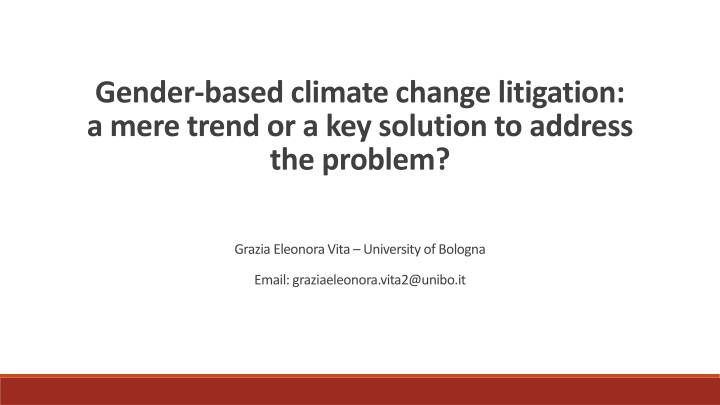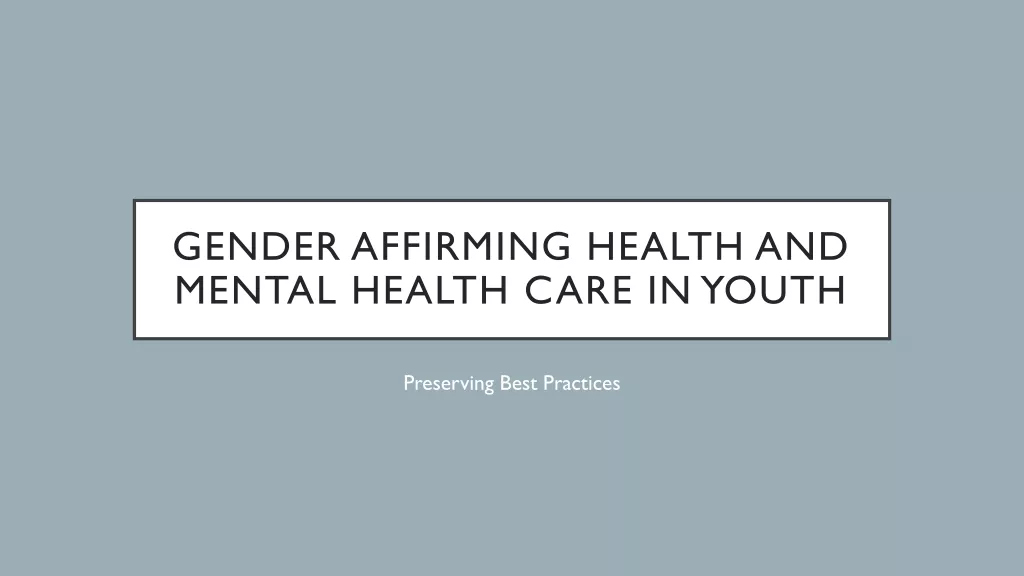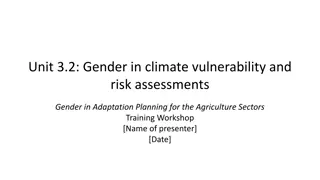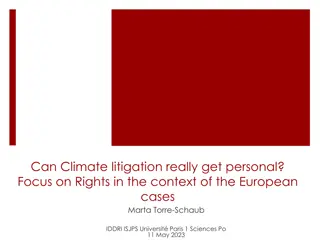Gender-based Climate Change Litigation: A Key Solution?
Gender-based climate change litigation is emerging as a potential solution to address the disproportionate impact of climate change on different genders. Various international bodies have recognized the importance of integrating a gender-responsive approach in climate action to uphold human rights, gender equality, and empowerment of women. Reports and resolutions underline the need to consider the gender aspect in climate-related policies and initiatives, highlighting the unequal effects of climate change on women and vulnerable populations. As climate change does not affect everyone equally, focusing on gender-specific impacts and solutions is crucial in achieving sustainable and equitable outcomes.
Download Presentation

Please find below an Image/Link to download the presentation.
The content on the website is provided AS IS for your information and personal use only. It may not be sold, licensed, or shared on other websites without obtaining consent from the author.If you encounter any issues during the download, it is possible that the publisher has removed the file from their server.
You are allowed to download the files provided on this website for personal or commercial use, subject to the condition that they are used lawfully. All files are the property of their respective owners.
The content on the website is provided AS IS for your information and personal use only. It may not be sold, licensed, or shared on other websites without obtaining consent from the author.
E N D
Presentation Transcript
Gender-based climate change litigation: a mere trend or a key solution to address the problem? Grazia Eleonora Vita University of Bologna Email: graziaeleonora.vita2@unibo.it
Gender and Climate Change Paris Agreement Preamble: Acknowledging that climate change is a common concern of humankind, Parties should, when taking action to address climate change, respect, promote and consider their respective obligations on human rights, the right to health, the rights of indigenous peoples, local communities, migrants, children, persons with disabilities and people in vulnerable situations and the right to development, as well as gender equality, empowerment of women and intergenerational equity. Articles 7 and 11: [ ] 5. Parties acknowledge that adaptation action should follow a country-driven, gender-responsive, participatory and fully transparent approach, [ ] [ ] 2. Capacity-building should be country-driven, based on and responsive to national needs, [ ] and should be an effective, iterative process that is participatory, cross-cutting and gender-responsive. Grazia Eleonora Vita University of Bologna
Reports and resolutions In 2018 the Committee on the Elimination of Discrimination against Women CEDAW already focused in its general recommendations on gender-related dimensions of disaster risk reduction in a changing climate (General recommendation no. 37/2018) In the same year the Human Rights Council (A/HRC/RES/38/4) requested OHCHR "to conduct, from within existing resources, an analytical study on the integration of a gender- responsive approach into climate action at the local, national, regional and international levels for the full and effective enjoyment of the rights of women The Inter-American Commission on Human Rights addressed this linkage in Resolution 3/2021 In 2022 the Special Rapporteur on violence against women and girls, explored the nexus between the climate crisis, environmental degradation and related displacement, and violence against women and girls (A/77/136) Will AOs take into consideration the gender aspect?
Commission on the Status of Women Grazia Eleonora Vita University of Bologna
Climate Change does notaffect everyone equally The impact of extreme heat, wildfires, floods, droughts, and unusual rainfall vary profoundly by gender, especially among poor and vulnerable population groups. Some of these differences can be seen: in health and education; in economic opportunities. E.g. Even though a third of women s employment worldwide is in the agricultural sector, women represent only 13 percent of landowners. This lack of control over resources translates into women receiving only 10 percent of total aid for agriculture, forestry, and fishing. Grazia Eleonora Vita University of Bologna
Women should be Given increased access to resources to reduce vulnerability and create more resilient households and communities; Involved in decision-making to help drive the adoption of climate change policies and strengthen mitigation and adaptation efforts. Ensuring a just transition should mean Ensuring that climate policies and investments are informed by these gendered realities Grazia Eleonora Vita University of Bologna
Emerging gender-based climate change litigation cases KlimaSeniorinnen v Switzerland (ECtHR) [Application no. 53600/20] still pending The case was filed against the Swiss government and several other Swiss authorities in 2016 by the Swiss Senior Women for Climate Protection, a group of more than 2,000 Swiss senior women. These women argue the government bodies are violating their human rights by failing to ensure Switzerland is on track to comply with the goal of the Paris Climate Agreement (in particular, applicants have argued for a violation of Arts. 2, 8, 6 and 13 of the ECHR). The country s Federal Administrative Court first rejected the case in 2018, saying that women could not be identified as victims because they were not exclusively affected by climate change. An appeal was then rejected by the Swiss Federal Supreme Court, which argued that the climate crisis was not affecting the women s right to life and health to a sufficient and specific extent, adding that the remedy the women were seeking must be achieved through political rather than legal means. Grazia Eleonora Vita University of Bologna
The gender aspect The peculiarity of this case lies in the gender aspect, which comes into play with regard to the admissibility issue. According to Swiss law (Art. 25 of the Administrative Procedure Act, VwVG) and Art. 34 ECHR, admissibility can be established if a violation of individual rights appears at least conceivable. KlimaSeniorinnen argued that, since they are both old and female, are disproportionately affected by climate change and should be considered a vulnerable group entitled to protection. KlimaSeniorinnen alerted the Court about how health, age, gender, and the climate crisis intersect. [See Crenshaw s concept of intersectionality and the case De Graffenreid v. General Motors] By proving their status of a vulnerable group, they seek to establish victim status according to Art. 34 ECHR. Grazia Eleonora Vita University of Bologna
Emerging gender-based climate change litigation cases Maria Khan et al. v. Federation of Pakistan et al. [No. 8960 of 2019] A group of female petitioners sued the Pakistani government in 2019 alleging that the federal government s inaction on climate change violated their fundamental rights including the right to a clean and healthy environment and a climate capable of sustaining human life, (a right which was previously recognized in Asghar Leghari v. Federation of Pakistan 2018 CLD 424). This coalition of women filed this case also on behalf of future generations against the Federation of Pakistan (like the Urgenda case). Furthermore, they argue that the consequences of global warming will have a greater effect on women because of social constraints that provide them with fewer opportunities than men. The government s climate inaction violates plaintiffs rights to equal protection under the law of non-discrimination based on sex. This is even more true in a country like Pakistan, which is already experiencing a lot of problems with extreme weather, floods, and high heat, which affect women and their lifestyle. Grazia Eleonora Vita University of Bologna
Future developments These gender-based climate claims: offer interesting impulses for the field of human rights and environmental law; it will be especially interesting to see if the gender aspect could represent a key-solution to address both the climate change issue and the gender equality goal; a judgment by the ECtHR would only bind Switzerland, but it could also set a precedent for the 40 other European countries and even beyond; more and more women will potentially have strong arguments if there are circumstances in which a policy is designed without any gender implications in mind, which is not uncommon; litigation will surely have to evolve and take more into consideration the peculiarities and differences of the players and interests at stake. Grazia Eleonora Vita University of Bologna
Equal access to resources and justice to all What is clear is that litigation can become a useful tool only if equal access is provided. Here are 4 suggestions advanced, among others, by the World Bank: 1. boost people s resilience and adaptive capacity in gender-sensitive ways and draft legislation addressing gender considerations; 2. Secondly: support women to thrive in greener economies (in terms of education and formation); 3. Thirdly: ensure that women s voices and leadership are incorporated into climate governance at the local and national levels; 4. Lastly: integrate gender equality into climate investments across sectors and expand gender- sensitive climate finance. Finally, in light of the Paris Agreement, also National Determined Contributions must be improved. Grazia Eleonora Vita University of Bologna
Thank you! Grazia Eleonora Vita University of Bologna Email: graziaeleonora.vita2@unibo.it























